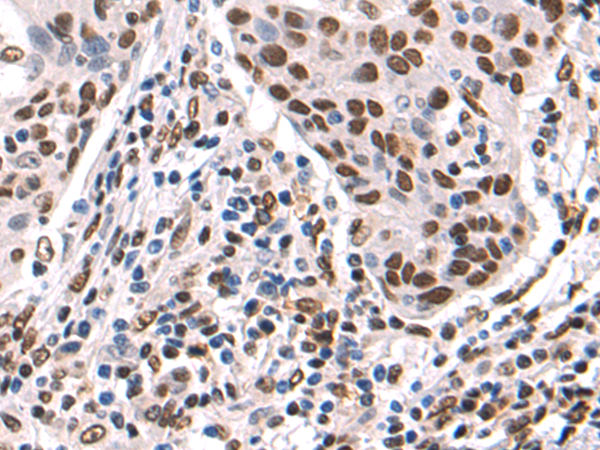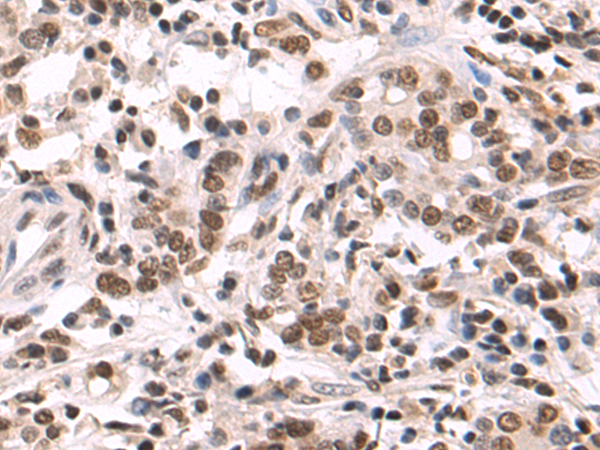

| WB | 咨询技术 | Human,Mouse,Rat |
| IF | 咨询技术 | Human,Mouse,Rat |
| IHC | 1/50-1/200 | Human,Mouse,Rat |
| ICC | 技术咨询 | Human,Mouse,Rat |
| FCM | 咨询技术 | Human,Mouse,Rat |
| Elisa | 1/5000-1/10000 | Human,Mouse,Rat |
| Aliases | PP68; NSAP1; GRYRBP; HNRNPQ; HNRPQ1; GRY-RBP; hnRNP-Q |
| Host/Isotype | Rabbit IgG |
| Antibody Type | Primary antibody |
| Storage | Store at 4°C short term. Aliquot and store at -20°C long term. Avoid freeze/thaw cycles. |
| Species Reactivity | Human, Mouse, Rat |
| Immunogen | Synthetic peptide of human SYNCRIP |
| Formulation | Purified antibody in PBS with 0.05% sodium azide and 50% glycerol. |
+ +
以下是3-4篇关于SYNCRIP抗体的参考文献及其简要摘要:
---
1. **文献名称**: *SYNCRIP regulates RNA translation and virus replication in human cells*
**作者**: Huang, L., et al.
**摘要**: 该研究利用SYNCRIP特异性抗体进行免疫沉淀和Western blot分析,发现SYNCRIP通过与病毒RNA结合促进某些RNA病毒的复制,揭示了其在宿主-病毒相互作用中的关键调控作用。
---
2. **文献名称**: *hnRNP Q/SYNCRIP interacts with the 3' untranslated region of hepatitis C virus RNA*
**作者**: Ito, T., & Lai, M.M.C.
**摘要**: 通过抗SYNCRIP抗体进行RNA免疫沉淀实验,研究发现SYNCRIP直接结合丙型肝炎病毒(HCV)RNA的3'非编码区,调控病毒RNA的稳定性和翻译效率。
---
3. **文献名称**: *SYNCRIP modulates neural stem cell differentiation by regulating mRNA stability*
**作者**: Zhang, Y., et al.
**摘要**: 使用SYNCRIP抗体进行免疫荧光和功能缺失实验,证明SYNCRIP通过结合特定mRNA并维持其稳定性,调控神经干细胞的增殖与分化,影响神经发育过程。
---
4. **文献名称**: *The role of SYNCRIP in miRNA-mediated gene silencing*
**作者**: Elkayam, E., et al.
**摘要**: 该研究通过SYNCRIP抗体的免疫共沉淀技术,揭示SYNCRIP作为microRNA效应复合物的组成部分,参与基因沉默过程,影响靶mRNA的翻译抑制和降解。
---
这些文献均以SYNCRIP抗体为工具,探究其在RNA代谢、病毒学及细胞分化中的功能。如需具体文章,建议通过PubMed或期刊数据库检索标题或作者获取全文。
SYNCRIP (Synaptotagmin Binding Cytoplasmic RNA Interacting Protein), also known as hnRNP Q or NSAP1. is a member of the heterogeneous nuclear ribonucleoprotein (hnRNP) family involved in RNA metabolism. It plays multifaceted roles in RNA processing, including splicing, transport, stability, and translational regulation. Structurally, it contains RNA recognition motifs (RRMs) and a prion-like domain, enabling interactions with RNA, proteins, and viral components. Studies link SYNCRIP to neurodevelopment, viral replication (e.g., HCV, Zika), and cancer progression, where it modulates oncogene or tumor-suppressor expression via mRNA binding.
SYNCRIP antibodies are essential tools for investigating its biological functions and mechanisms. These antibodies enable the detection of SYNCRIP expression levels, subcellular localization (primarily cytoplasmic), and interaction partners through techniques like Western blotting, immunofluorescence, and co-immunoprecipitation. In cancer research, they help assess SYNCRIP's role in tumorigenesis, metastasis, or therapy resistance. In neuroscience, they aid in studying its involvement in neuronal RNA transport and synaptic plasticity. However, antibody specificity remains a challenge due to structural similarities among hnRNP family members. Validated SYNCRIP antibodies are critical for distinguishing its isoform-specific functions and exploring its potential as a therapeutic target or biomarker in diseases.
×